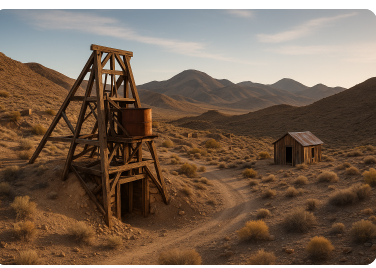1. Introduction
Nestled in the rugged terrain of Esmeralda County, Nevada, the Del Bandito Mine stands as a testament to the boom-and-bust cycles that defined the American West. The story of the Del Bandito Mine Esmeralda NV history is not just about extracting minerals — it’s a rich saga of ambition, perseverance, community growth, and eventual decline. This mine, often overlooked in mainstream mining history, played a significant role in shaping the local economy during Nevada’s peak mining era.
2. Geographic and Geological Context
Esmeralda County is situated in the southwestern corner of Nevada, known for its arid landscape, rolling mountains, and hidden mineral riches. The Del Bandito Mine was strategically located near key geological fault lines rich in precious metals. These natural conditions made the region a hotspot for mining enthusiasts during the late 1800s and early 1900s.
The mineral composition of the Del Bandito site included:
| Mineral | Abundance | Notes |
|---|---|---|
| Gold | High | Main driver of early mining interest |
| Silver | Moderate | Supplemented gold production |
| Quartz | Common | Often found alongside gold veins |
| Pyrite | Traces | Typically associated with gold ores |
This favorable geology made Del Bandito a target for early prospectors looking to strike it rich.
3. Early Discovery and Establishment
The Del Bandito Mine Esmeralda NV history likely began in the late 1800s, during a time when the American West was still full of promise and peril. While no definitive documentation exists about the very first claim, oral histories suggest that the mine was discovered by renegade prospectors—possibly outlaws—who gave the mine its unique Spanish name, “Del Bandito,” meaning “The Bandit.”
By the early 1900s, word of gold discoveries led to a flurry of staking claims and mining activity. Small operations soon grew into a full-scale mining camp complete with tents, wooden cabins, and supply stores. This marked the true beginning of Del Bandito’s rise.
4. Mining Operations and Techniques
Mining at Del Bandito started with rudimentary hand tools and pans but quickly evolved into more industrial techniques as the site proved profitable. Steam-powered drills, horse-drawn carts, and stamp mills were introduced to boost output and profitability.
Common mining methods used:
- Hard Rock Mining: For extracting gold embedded in quartz veins.
- Placer Mining: Initially used in nearby creek beds.
- Stamp Milling: To crush rock and extract precious metals.
The workforce was diverse, composed of local settlers, immigrants, and traveling miners drawn by the promise of gold. Working conditions were harsh — temperatures could soar in the summer and plummet in the winter, and accidents were not uncommon.
5. Economic Impact
During its peak, the Del Bandito Mine was a cornerstone of the regional economy. Not only did it employ dozens of workers, but it also stimulated business for nearby towns like Goldfield and Tonopah, which saw increased activity in banking, lodging, and transportation.
Estimated contributions:
- Jobs created: ~120 (direct and indirect)
- Gold output: Approx. $300,000 (early 20th century value)
- Business impact: Surge in supply stores, blacksmiths, and general goods
The prosperity of Del Bandito mirrored the economic patterns seen in more famous Nevada mining towns, albeit on a smaller scale.
6. Challenges and Decline
Despite its early success, the Del Bandito Mine was not immune to the problems that plagued many mining ventures of its time. Several key challenges led to its eventual decline:
- Ore Depletion: The richest veins were quickly exhausted.
- Market Fluctuations: Gold and silver prices were unstable, especially after WWI.
- Remote Location: Difficult access to transport and supplies hindered sustained growth.
- Environmental Impact: Scarce water and growing awareness of environmental damage started to raise concerns.
By the 1930s, operations began winding down, and many miners moved on to more promising opportunities elsewhere.
7. Closure and Aftermath
The official closure date of the Del Bandito Mine is not well-documented, but most evidence suggests it ceased major operations by the early 1940s. Abandoned shafts, rusting equipment, and crumbling infrastructure were all that remained.
For the local population, the closure was devastating. Many families relocated, and nearby businesses shuttered. Yet, the legacy of the mine continued through stories passed down generations and the physical remnants still dotting the landscape.
8. Legacy and Historical Significance
Today, the Del Bandito Mine Esmeralda NV history is recognized as an important chapter in Nevada’s mining narrative. While not as famous as the Comstock Lode or Virginia City, Del Bandito serves as a symbol of the smaller, equally significant mining operations that dotted the state.
Efforts have been made by local historians and preservationists to:
- Document oral histories from descendants of miners
- Preserve mining equipment and tools
- Protect the site from vandalism and natural decay
In recent years, the site has gained attention among history buffs and geologists who seek to understand the full breadth of Nevada’s mining boom.
9. Current Status and Tourism
Although no longer operational, the Del Bandito Mine site remains a fascinating destination for those interested in ghost towns and mining history. Adventurous travelers can still visit the area, though caution is advised due to unstable structures and remote access.
Tourism features:
| Attraction | Description |
|---|---|
| Mine Shafts | Mostly collapsed, but some visible entrances remain |
| Old Equipment | Rusted machinery gives a glimpse into mining life |
| Interpretive Signs | Installed by local historical societies |
| Photography | Popular for rugged desert shots and historic ambiance |
Those who visit the site can not only experience a piece of history but also gain a deeper appreciation for the challenges and triumphs of Nevada’s early miners.
10. Conclusion
The Del Bandito Mine in Esmeralda, NV, may not be a household name, but its contribution to Nevada’s mining heritage is undeniable. From a bandit’s hidden discovery to a bustling gold producer and finally a silent desert monument, the journey of Del Bandito is filled with intrigue, hard work, and resilience.
Related Articles
Inside Närkes Elektriska: Sweden’s Premier Electrical Services Company
Remembering Aiden Langston Utah – A Life of Passion, Purpose, and Inspiration
Bumped Things NYT Crossword Clue Explained – Meaning, Answers & Solving Tips
InfluncersGoneWild: The Shocking Rise, Impact, and Ethics of Social Media Extremes

